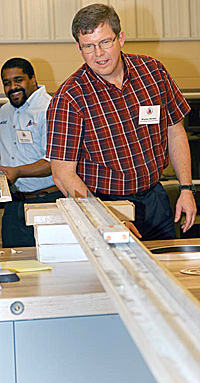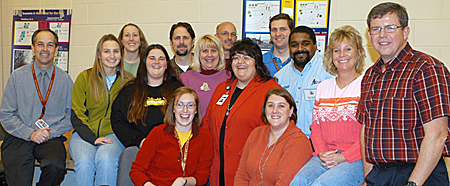
| CONNECTIONS |
IDAHO
ITD
HOME
511 TRAVEL SERVICES
IDAHO
DMV
ITD
NEWS
HIGHWAY
SAFETY
IDAHO STATE POLICE
STATE OF IDAHO
NIATT
NATIONAL
AASHTO
AAMVA
AAA of IDAHO
FEDERAL HIGHWAYS
FEDERAL AVIATION
IDAHO STATE POLICE
NHTSA
NTSB
TRB
U.S. DOT
TRANSPORTER
Archives
Milestones
Comments
Idaho
Transportation
Department
Office of Communications
P.O. Box 7129
Boise, ID 83707
208.334.8005
Fax: 208.334.8563


ITD
volunteers help teachers connect
classroom concepts to real-world challenges
Learning to apply classroom concepts to real-world challenges is the goal of a unique training partnership launched recently by ITD volunteers and Nampa School District teachers.
ITD engineers joined with teachers from Nampa’s Columbia High School in activities ranging from building simulated cities to gliding “race cars” down a magnetic track. The training was part of the Transportation and Civil Engineering (TRAC) program sponsored by the American Association of State Highway and Transportation Officials (AASHTO).
The TRAC program began in 1993 as AASHTO’s educational outreach designed to encourage students in grades 5 through 12 to consider careers in transportation and civil engineering, according to Tate Jackson, TRAC national manager. The program is offered in 26 other states, but Columbia, chosen for its engineering academy, is the first Idaho high school to use TRAC.
|
|
“TRAC is a long-range recruiting tool,” Jackson said, adding that there is a huge need for engineers in transportation departments across the U.S.
Assistant Chief Engineer for ITD Greg Laragan, a TRAC volunteer, echoed the sentiment and said he believes that difficulties in recruiting and retaining engineers may get even worse.
“We already see that getting involved at the college and post-graduate level is not leading to the participation we, as a department, need,” he said.
Laragan said he supports the TRAC program because it is able to present a broader view of engineering in schools.
Passion
for profession
 “Even
if they (students) don’t go on to be engineers, we need people
interested in transportation fields in general,” Laragan explained.
“Transportation is more than just building roads.
“Even
if they (students) don’t go on to be engineers, we need people
interested in transportation fields in general,” Laragan explained.
“Transportation is more than just building roads.
“I’m not involved in this program because my boss told me to,” he added. “I’m here because I have a passion for this work.”
ITD volunteer Pam Golden, assistant traffic engineer for District 3, said she also believes in the value of the TRAC program.
“It gets us in front of these kids and shows that our jobs can be fun and important,” she said. “Hopefully, some of them will go into civil engineering in college and remember that ITD is a great place to work.”
By engaging students in solving real-world problems, TRAC connects young people to the real work of transportation, Jackson said. TRAC’s specific focus of improving workforce diversity also helps resolve a pressing problem of how to draw more talented women and minorities into transportation fields.
At the heart of the TRAC program are self-contained education modules featuring professionally developed curricula that meet national standards of learning. Each module contains the equipment, software and supplies needed to perform hands-on activities related to:
-
Bridge Design
-
SimCity
-
Design and Construction
-
Environmental Engineering
-
Highway Safety
-
Magnetic Levitation
-
Motion
-
Traffic Technology
Each module has up to five activities, allowing teachers to tailor the lessons to their individual needs.
TRAC PAC activities assist mathematics teachers in illustrating math concepts at every level from algebra to advanced calculus. Physical science teachers can find activities useful in working with friction, gravity, magnetism, motion and structures. Social science teachers can utilize TRAC PAC interactive modules for lessons in urban planning, environmental exploration, and technology’s relationship to society, politics and government regulations.
 ITD
volunteers demonstrate how TRAC PAC activities work and show how to
apply the activities to what students are learning in class. The volunteers
also serve as role models who answer questions about transportation
careers and who help students understand the connection between concepts
learned in the classroom and how those concepts get applied outside
the classroom.
ITD
volunteers demonstrate how TRAC PAC activities work and show how to
apply the activities to what students are learning in class. The volunteers
also serve as role models who answer questions about transportation
careers and who help students understand the connection between concepts
learned in the classroom and how those concepts get applied outside
the classroom.
The Nampa School District was a perfect fit for the partnership with their specialized technical program that includes pre-engineering, said ITD Human Resources Manager Mary Harker.
“This gives ITD the opportunity to reach students earlier in their educational career,” she said. “These students today are our potential employees of the future.”
The TRAC program is scheduled to begin at Columbia High School on Feb. 4.
“I like that the program introduces kids to real transportation engineering concepts through fun hands-on modules while hopefully banishing the preconceived notion that engineers do nothing but crunch numbers all day long,” Golden said.
“Plus, as a parent of two young children, I am hopeful that they will be able to benefit from programs like TRAC as they go through school.”
TRAC
for the future
ITD Engineer Wayne Herbel said that working with the Columbia teachers
was fun and that the TRAC training had a good balance between teachers
and engineers.
“The teachers helped keep discussions from getting too technical and the engineers were able to show that they’re not all a bunch of stuffy, stick-in-the-mud nerds,” he said.
Golden said the group shared a lot of laughs during the two days of training.
“I had not been aware of the small learning communities concept prior to our visit and it was inspiring to see how a group of interdisciplinary teachers have come together to teach in an engineering focused environment,” she said.
“There wasn’t a module that we didn’t have fun with,” she said. “My personal favorite was the magnetic levitation model because we got quite competitive as we raced our ‘cars’ down the parallel tracks.”

Published 12-21-07